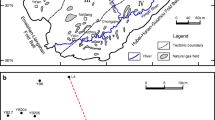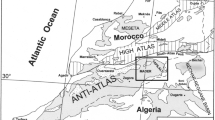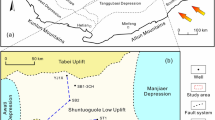Abstract
Wide distribution of the black shales and diversification of the graptolite fauna in South China during the Late Ordovician resulted from its unique paleogeographic pattern, which was significantly affected by the paleogeographic evolution of the Lower Yangtze region. In the study, 120 Upper Ordovician sections from the Lower Yangtze region were collected, and a unified biostratigraphic framework has been applied to these sections to establish a reliable stratigraphic subdivision and correlation. Under the unified time framework, we delineate the distribution area of each lithostratigraphic unit, outline the boundary between the sea and land, and reconstruct the paleogeographic pattern for each graptolite zone. The result indicates that, with the uplift and expansion of the ‘Jiangnan Oldland’ in the beginning of the late Katian, the oldland extended into the Yangtze Sea gradually from south to north, which finally separate the Jiangnan Slope and the Yangtze Platform. Consequently, the longstanding paleogeographic pattern of “platform-slope-basin” in South China was broken. The paleogeographic change led to sedimentary differentiation among the two sides of the ‘Jiangnan Oldland’ during the Late Ordovician. This event also led to the closure of the eastern exit of the Upper Yangtze Sea, and formed a semi-closed, limited and stagnant environment for the development of the organic-rich black shales during the Late Ordovician. The major controlling factors of these paleogeographic changes in the Lower Yangtze region were not consistent from the Katian to the Hirnantian. In the late Katian, the sedimentary differentiation between the east and west sides mostly resulted from regional tectonic movement - the Kwangsian Orogeny. However, during the Hirnantian, the whole Yangtze region became shallower, which was mostly influenced by the concentration of the Gondwana ice sheet and the consequent global sea level drop.
Similar content being viewed by others
References
Bureau of Geology and Mineral Resources of Jiangxi Province. 1984. Regional Geology of Jiangxi Province (in Chinese). Beijing: Geological Publishing House. 921
Cao Q Y, Feng H Z, Fang Y T, Wang H F. 1998. Graptolite zonation of the Upper Ordovician Wufeng Formation in Xiushui Gorge, Jiangxi Province (in Chinese). Geol J China Univ, 4: 318–323
Chen H C, Wu Q Q. 1989. Stratigraphic Memoir of Lower-Middle Yangtze Valley (in Chinese). Hefei: Anhui Science & Technology Publishing House. 597
Chen Q. 2014. Quantitative study on graptolite biodiversity and palaeogeography in South China during the Ordovician and Silurian transition (in Chinese with English Summary). Doctoral Dissertation. Beijing: University of Chinese Academy of Sciences
Chen X, Chen T E, Zou X P, Qiu J Y, Ni Y N, Yang X C. 1988. Ordovician system of the Lower Yangtze region in Jiangsu Province (in Chinese). In: Academy of Geological Sciences, Jiangsu Bureau of Petroleum Prospecting, Nanjing Institute of Geology and Palaeontology, Chinese Academy of Sciences, eds. Sinian-Triassic Biostratigraphy of the Lower Yangtze Peneplatform in Jiangsu Region. Nanjing: Nanjing University Press. 81–126
Chen X, Fan J X, Chen Q, Tang L, Hou X D. 2014. Toward a stepwise Kwangsian Orogeny. Sci China Earth Sci, 57: 379–387
Chen X, Melchin M J, Fan J, Mitchell C E. 2003. Ashgillian graptolite fauna of the Yangtze region and the biogeographical distribution of diversity in the latest Ordovician. Bull de la Societe Geologique de France, 174: 141–148
Chen X, Rong J Y. 1992. Ordovician plate tectonics of China and its neighbouring regions. In: Webby B D, Laurie J R, eds. Global Pespectives on Ordovician Geology. Rotterdam: A. A. Balkema. 277–291
Chen X, Rong J Y, Fan J X, Zhan R B, Mitchell C E, Harper D A T, Melchin M J, Peng P A, Finney S C, Wang X F. 2006. The Global boundary Stratotype Section and Point (GSSP) for the base of the Hirnantian Stage (the uppermost of the Ordovician System). Episodes, 29: 183–196
Chen X, Rong J Y, Li Y, Boucot A. 2004. Facies patterns and geography of the Yangtze region, South China, through the Ordovician and Silurian transition. Palaeogeogr Palaeoclimatol Palaeoecol, 204: 353–372
Chen X, Rong J Y, Mitchell C E, Harper D A T, Fan J X, Zhan R B, Zhang Y D, Li R Y, Wang Y. 2000. Late Ordovician to earliest Silurian graptolite and brachiopod biozonation from the Yangtze region, South China, with a global correlation. Geol Mag, 137: 623–650
Chen X, Rong J Y, Wang X F, Wang Z H, Zhang Y D, Zhan R B, Zhou Z Y, Chen T E, Geng L Y, Deng Z Q, Hu Z X, Dong D Y, Li J. 1995. Correlation of the Ordovician rocks of China—Charts and explanatory notes. Intern Union Geol Sci Publ, 31: 1–104
Chen X, Zhang Y D, Fan J X, Tang L, Sun H Q. 2012. Onset of the Kwangsian Orogeny as evidenced by biofacies and lithofacies. Sci China Earth Sci, 55: 1592–1600
Compiling Group of Regional Stratigraphy Chart of Jiangxi. 1980. Regional Stratigraphy Chart of East China: Jiangxi Province (in Chinese). Beijing: Geological Publishing House. 205
Cooper R A, Sadler P M. 2012. The Ordovician Period. In: Gradstein F M, Ogg J G, Smith A G, Ogg G M, eds. The Geologic Time Scale 2012. Amsterdam: Elsevier. 489–523
Fan J X, Chen Q, Melchin M J, Sheets H D, Chen Z Y, Zhang L N, Hou X D. 2013. Quantitative stratigraphy of the Wufeng and Lungmachi black shales and graptolite evolution during and after the Late Ordovician mass extinction. Palaeogeogr Palaeoclimatol Palaeoecol, 389: 96–114
Fan J X, Melchin M J, Chen X, Wang Y, Zhang Y D, Chen Q, Chi Z L, Chen F. 2012. Biostratigraphy and geography of the Ordovician-Silurian Lungmachi black shales in South China. Sci China Earth Sci, 54: 1854–1863
Finnegan S, Bergmann K, Eiler J M, Jones D S, Fike D A, Eisenman I, Hughes N C, Tripati A K, Fischer W W. 2011. The magnitude and duration of Late Ordovician-Early Silurian glaciation. Science, 331: 903–906
Guo T L, Zhang H R. 2014. Formation and enrichment mode of Jiaoshiba shale gas field, Sichuan Basin (in Chinese). Petrol Explor Dev, 41: 28–36
Lai C G, Jin R G, Lin B Y, Huang Z G. 1993. Biofacies, Sedimentary Facies and Palaeogeographic Characteristics of the Ordovician in the Lower Yangtze Area (in Chinese). Beijing: Geological Publishing House. 87
Li J J. 1983. Zonation and correlation of Ordovician rocks in southern Anhui with a note on some important graptolites (in Chinese). Bull Nanjing Inst Geol Palaeontol, Acad Sin, 6: 133–158
Liang D G, Guo T L, Chen J P, Bian L Z, Zhao J. 2008. Some progresses on studies of hydrocarbon generation and accumulation in marine sedimentary regions, southern China (Part 1): Distribution of four suits of regional marine source rocks, South China (in Chinese). Mar Origin Petrol Geol, 13: 1–16
Lu Y H, Zhu Z L, Qian Y Y, Zhou Z Y, Chen J Y, Liu G W, Yu W, Chen X, Xu H K. 1976. Ordovician biostratigraphy and palaeogeography of China (in Chinese). Mem Nanjing Inst Geol Palaeont, 7: 1–90
Ma L, Chen H J, Gan K W, Xu K D, Xu X S, Wu G Y, Ye Z, Liang X, Wu S H, Qiu Y Y, Zhang P L, Ge P P. 2004. Geotectonics and Petroleum Geology of Marine Sedimentary Rocks in Southern China (in Chinese). Beijing: Geological Publishing House. 451
Melchin M J, Sadler P M, Cramer B D. 2012. The Silurian Period. In: Gradstein F M, Ogg J G, Smith A G, Ogg G M, eds. The Geologic Time Scale 2012. Amsterdam: Elsevier. 525–558
Mu E Z. 1954. On the Wufeng shale (in Chinese). Acta Palaeont Sin, 2: 153–168
Mu E Z. 1974. Evolution, classification and distribution of graptoloidea and graptodendroids. Sci Sin, 17: 227–238
Mu E Z. 1983. Ordovician ecostratigraphic types and biogeographic regions in China (in Chinese). In: Editorial Board of the Basic Theory of Paleontology, ed. Paleobiogeographic Province in China. Beijing: Science Press. 16–31
Mu E Z, Li J J, Ge M Y, Chen X, Lin Y Q, Ni Y N. 1993. Upper Ordovician Graptolites of Central China Region, Palaeontol Sinica (B29) (in Chinese with English summary). Beijing: Science Press. 393
Mu E Z, Zhu Z L, Lin Y K, Wu H J. 1984. The Ordovician-Silurian boundary in Yichang, Hubei. In: Nanjing Institute of Geology and Palaeontology, ed. Stratigraphy and Palaeontology of Systemic Boundaries in China, 1. Ordovician-Silurian Boundary. Hefei: Anhui Science & Technology Publishing House. 15–44
Regional Geological Survey Team, Bureau of Geology and Mineral Resources of Anhui Province. 1989. Stratigraphic Memoir of Anhui Province—The Ordovician System (in Chinese). Hefei: Anhui Science & Technology Publishing House. 234
Rong J Y. 1984a. Distribution of the Hirnantia Fauna and its meaning. In: Bruton D L, ed. Aspects of the Ordovician System. Palaeontological Contribution from the University of Oslo, 295. Universitetsforlaget. 101–112
Rong J Y. 1984b. Ecostratigraphic evidences of the Upper Ordovician regressive sequences in the Upper Yangtze region and the effect of glaciation (in Chinese). J Stratigr, 8: 19–29
Rong J Y, Chen X. 1987. Faunal differentiation, biofacies and lithofacies pattern of Late Ordovician (Ashgillian) in South China (in Chinese). Acta Palaeont Sin, 26: 507–535
Rong J Y, Zhan R B, Xu H G, Huang B, Yu G H. 2010. Expansion of the Cathaysian Oldland through the Ordovician-Silurian transition: Emerging evidence and possible dynamics. Sci China Earth Sci, 53: 1–17
Shao W G, Wan H. 1993. Problems on the Silurian System in the Northwestern Jiangxi Province (in Chinese). Geol Jiangxi, 7: 184–191
Sheehan P M. 2001. The Late Ordovician mass extinction. Annu Rev Earth Planet Sci, 29: 331–364
Wang H Z. 1985. Atlas of the Palaeogeography of China (in Chinese). Beijing: Cartographic Publishing House. 143
Wang Z G. 2015. Breakthrough of fuling shale gas exploration and development and its inspiration (in Chinese). Oil Gas Geol, 36: 1–6
Wu H R. 2005. Discussion on tectonopalaeogeography of Lower Yangtze area during the Caledonian Period (in Chinese). J Palaeogeol, 7: 243–248
Xia B D, Lü H B. 1988. The sedimentologic and tectonic evolution in the Zhejiang-Anhui-Jiangsu region (in Chinese). Acta Geol Sin, 62: 301–310
Xing F M, Xu X, Chen J F, Zhou T X, Foland K A. 1992. The Late Proterozoic continental accretionary history of the southeastern margin of the Yangtze Platform (in Chinese). Acta Geol Sin, 66: 59–72
Yan D T, Chen D Z, Wang Q C, Wang J G. 2012. Predominance of stratified anoxic Yangtze Sea interrupted by short-term oxygenation during the Ordo-Silurian transition. Chem Geol, 291: 69–78
Yu J H, Xia S F, Fang Y T. 1976. Ordovician System of Xiushui drainage area, Jiangxi (in Chinese). Bull Nanjing Univ-Nat Sci, 12: 57–71
Zhan R B, Jin J S. 2007. Ordovician-Early Silurian (Llandovery) Stratigraphy and Palaeontology of the Upper Yangtze Platform, South China. Beijing: Science Press. 169
Zhang Y D, Chen X, Yu G H, Goldman D, Liu X. 2007. Ordovician and Silurian Rocks of Northwest Zhejiang and Northeast Jiangxi Provinces, SE China. Hefei: University of Science and Technology of China Press. 189
Zhou M K, Wang R Z, Li Z M, Yuan E R, He Y X, Yang J L, Hu C M, Xiong D Q, Lou X Y. 1993. Ordovician and Silurian Lithofacies Paleogeography and Mineralization in South China (in Chinese). Beijing: Geological Publishing House. 111
Zou C N, Dong D Z, Wang S J, Li J Z, Li X J, Wang Y M, Li D H, Cheng K M. 2010. Geological characteristics and resource potential of shale gas in China. Petrol Explor Develop, 37: 641–653
Acknowledgements
This study was supported by National Natural Science Foundation of China (Grant Nos. 41502025, U1562213 and 41521061), Chinese Academy of Sciences (Grant No. XDB10010100), and the China Geological Survey Project (Grant No. 2016-03019). This is a contribution to the “Geobiodiversity Database” and IGCP 653 Project “The onset of the Great Ordovician Biodiversity Event”.
Author information
Authors and Affiliations
Corresponding author
Rights and permissions
About this article
Cite this article
Chen, Q., Fan, J., Zhang, L. et al. Paleogeographic evolution of the Lower Yangtze region and the break of the “platform-slope-basin” pattern during the Late Ordovician. Sci. China Earth Sci. 61, 625–636 (2018). https://doi.org/10.1007/s11430-018-9170-y
Received:
Revised:
Accepted:
Published:
Issue Date:
DOI: https://doi.org/10.1007/s11430-018-9170-y




